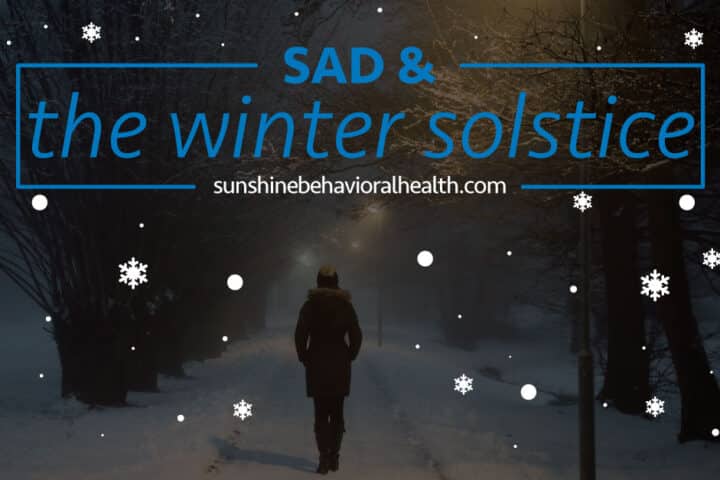
Winter Solstice Blues: How to Battle Seasonal Affective Disorder (SAD)
December 21 officially marks the winter solstice, the start of winter, and is in the thick of holiday festivities. Although some people approach seasonal events with warmth and joy, others feel sad due to the turn of the season. Here are some strategies that could help.
In the Northern Hemisphere, the winter solstice occurs on December 21, 2020. For many, the next couple of months will be the coldest yet. Earlier sunsets, darker nights, and colder environments can mean more time indoors and coziness for some, but others miss the sunshine and experience depressive moods.
What is seasonal affective disorder (SAD)?
If you or a loved one has experienced this seasonal depression, you could be experiencing a phenomenon called seasonal affective disorder (SAD). This type of depression occurs mostly during the beginning of the fall season into winter, but some experience it during spring and summer. This condition can also co-occur with other mental health problems such as substance abuse, anxiety, or personality disorders.
Professionals can help people address SAD. Starting psychotherapy or counseling can allow you to get to the root cause of seasonal affective depression. There are also other strategies that can boost your mood in the coming winter months.
Invest in a white light lamp
One major reason why seasonal depression is often related to winter and fall timelines is because those periods lack sunshine. Exposure to sunlight boosts serotonin levels, which can improve one’s mood. Some people who are sensitive to seasonal changes quickly respond to the lack of sunlight, so receiving another source of white light can be helpful.
Consider investing in a lamp with bright white light to help relieve SAD symptoms. Such lamps can provide light therapy and are known by various names, such as light therapy boxes or happy lamps.
Before buying a lamp, you might want to do some research or ask a therapist about recommended brands and usage instructions. Light therapy can aid in treating SAD, so buying one to use in your home could provide real benefits.
Find other mood boosters
Understandably, the lack of sunshine and cold weather can affect us during winter. But there are still some options you can explore to boost your mood during this time. You can try:
- Listening to music: There’s a reason why music is a universal language that can soothe the soul. It can elicit positive feelings and thoughts. Try upbeat tunes, light melodies, or cozy jazz music to help during low moods.
- Practicing art therapy: You don’t have to be an artist to create something that boosts your mood. Draw, sketch, paint, or complete some DIY home projects to improve your confidence and find an outlet for your emotions.
- Journaling: For many, writing is a cathartic experience. Write about your frustrations, goals, and what you think needs to be done to take yourself to the next level. Writing about what you truly feel allows you to release emotional and mental burdens.
Mood boosters are, of course, not limited to this list. You can explore your own, such as walking in nature, meditating, or volunteering.
Take care of your body
The battle against seasonal affective disorder can become even more difficult when you have other health issues. You can relieve many symptoms of SAD by taking care of your health and wellness.
Make sure that you are getting the right macronutrients and micronutrients in your diet. For macronutrients, nutritionists recommend consuming appropriate servings of protein, carbohydrates, and fats. Micronutrients can be found in vegetables and fruits or through dietary supplements.
To make the most of your health goals, also aim to cut out or reduce the amount of processed foods in your diet, replacing them with whole foods and nutrient-dense sources.
Also, try to be physically active for at least 20-30 minutes a day, four to five times a week, to boost your health and serotonin levels during exercise. Getting enough sleep is also crucial to keeping your mood stable during the colder months.
Overcoming SAD: small steps to victory
Even if SAD comes and goes, it doesn’t mean that you have to silently endure its burdens at specific times of the year. By enlisting the help of health professionals and practicing some basic strategies, you can overcome SAD, even during the thick of winter.
Sources
mayoclinic.org – Seasonal Affective Disorder (SAD)
sunshinebehavioralhealth.com – Co-Occurring Disorders & Addiction: Examining the Not-So-Hidden Links
time.com – Why Sunlight Is Good For You
uofmhealth.org – Seasonal Affective Disorder: Using Light Therapy
theeverygirl.com – 30 Home Projects to Tackle This Weekend
A Message From Our CEO
Medical disclaimer:
Sunshine Behavioral Health strives to help people who are facing substance abuse, addiction, mental health disorders, or a combination of these conditions. It does this by providing compassionate care and evidence-based content that addresses health, treatment, and recovery.
Licensed medical professionals review material we publish on our site. The material is not a substitute for qualified medical diagnoses, treatment, or advice. It should not be used to replace the suggestions of your personal physician or other health care professionals.





